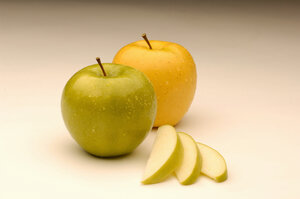Going grocery shopping? Eat an apple first.
Shoppers who eat a piece of apple before a grocery shopping trip buy more fruits and vegetables than their counterparts, according to a new study. The findings support other research suggesting that small, outside cues can have a big impact on our food choices.

Eating an apple before grocery shopping can lead to more fruit and vegetable purchases, according to researchers at Cornell University.
Okanagan Specialty Fruits/AP/File
Can an apple a day keep the junk food away? It just might, according to a new study from food psychologists at Cornell University.
In research published in the academic journal “Psychology and Marketing,” last week, Aner Tal and Brian Wansink of Cornell’s Food and Brand Lab divided 120 individuals into three random groups. Before they went grocery shopping, members of the first group were given a piece of an apple. The second group got a piece of a cookie, and the third group nothing at all. Afterward, researchers tracked the purchases of each group.
On average, shoppers in the apple group bought 28 percent more fruits and vegetables than the cookie group and 25 percent more fruits and vegetables than the group given nothing. They repeated the experiment with test subjects shopping virtually and found similar results: Apple eaters opted for more healthy items, while cookie eaters chose more junk food items.
“What this teaches us,” Dr. Tal says in the data release, “is that having a small healthy snack before shopping can put us in a healthier mindset and steer us towards making better food choices.”
We’ve all tried, and failed, to get through the grocery store on an empty stomach without reaching for the ice cream and Cheetos, so the fact that a well-timed snack might help clear our heads and improve our decisionmaking isn’t especially surprising. But Tal and Dr. Wansink’s research takes it a step further: The type of snack matters, priming us to consider more nutritious fare.
Other findings bolster the notion that small outside influences can have a positive impact on our food choices. In a study released late last month and presented at the Pediatric Academic Societies annual meeting in San Diego, researchers placed green, smiley-faced icons near cartons of nonfat milk and next to vegetables in the cafeteria of a Cincinnati elementary school. The percentage of kids who selected the milk for their lunches more than quintupled, surging from 7 percent to 48 percent overall. They also chose more vegetables. Before the smiley faces, the kids ate an average of 0.74 servings per lunch. At the end of the study, that was up to an average of 1.2 servings per child.
Researchers also tested an approach that rewarded children with prizes for eating more vegetables, and found that the smiley face method was far more effective. The findings are a hopeful sign for nutrition advocates, because they hint at concrete ways of changing people’s habits with minimal investment. Particularly for programs in low-income neighborhoods and public schools, that could be invaluable.
"It looks like we found a very promising, low-cost and effective way of improving the nutrition of elementary school children," Robert Siegel, the lead researcher of the Cincinnati school study and a pediatrics professor at the University of Cincinnati, said in a statement last week.

